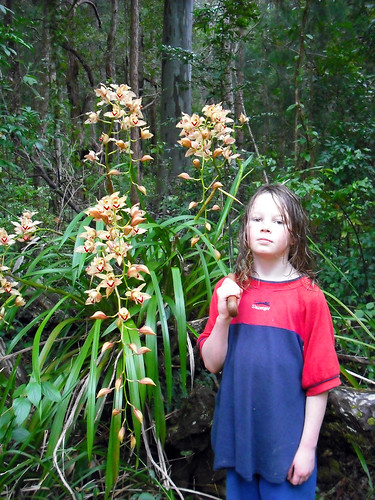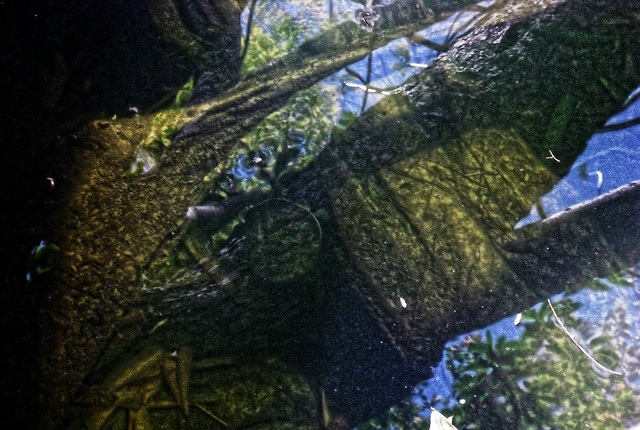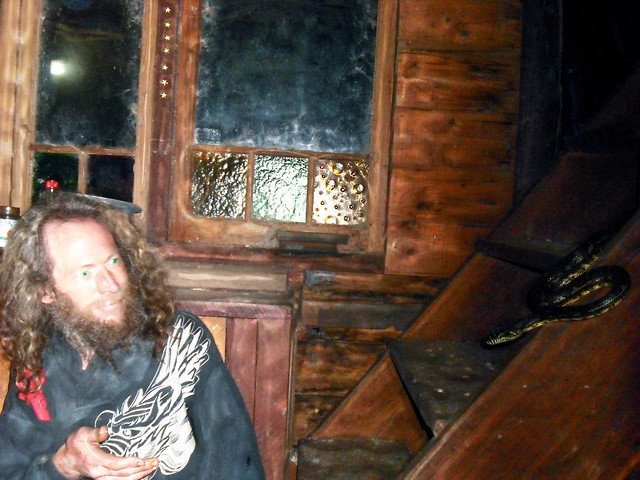Bringing Yourself Back to the Present
From Abstraction and Absorption to
Awareness
Wherever you are and whatever you’re doing, there are always three different things you can do with your attention. Firstly, you can give it to the thought-chatter in your head - the stream of mental associations (images, memories, future projections, worries etc.) that runs through our minds when our attention isn’t occupied. Secondly, you can choose to immerse your attention in tasks or distractions, such as TV programmes, magazines, the Internet or a hobby. Or thirdly, you can give your attention on your actual present experience - that is, focus your attention on your actual surroundings, and the experiences you have in those surroundings.
For example, if you’re in waiting room at the doctor’s surgery, you can either daydream (perhaps think about what you’re going to do at the weekend, or mull over some problems you have at work), immerse your attention in a magazine or your I-phone, or observe the other people around you and the objects and décor of the room itself. Or when you go for a jog, you can either daydream, listen to an audio book on your I-pod, or give your attention to your surroundings, the scenery you pass and the nature around you.
In shorthand, you can think of these three states as ‘the three As’: abstraction (i.e. immersion in thought-chatter), absorption (i.e. in activities or distractions) and awareness (i.e. conscious attention to our experience). It isn’t completely cut and dried, of course – in a state of abstraction or absorption, you’re usually still in a state of partial awareness too. For example, even if you’re daydreaming or listening to an audio book while jogging, you’re obviously still aware of your surroundings to a degree - enough to pay attention to the traffic, or to keep to your normal route. But usually this is only a very basic and functional awareness; the largest proportion of your mental energy is given up to absorption or abstraction.
Every moment of our lives, we unconsciously evaluate these three options and choose one of them - and it’s usually one of the first two that we prefer.
Think about how much time you spend in each of these three states. As a percentage, estimate what proportion of a typical day you spend in a state of abstraction, a state of absorption and a state of awareness….
I have asked many people this question in workshops and on-line courses, and people almost always estimate that they spend by far the least proportion of their days in a state of awareness. As a rough average, people say they spend 5-15% of their time in awareness, 50-60% of their time in absorption, and 25-35% in abstraction.
This is a great shame, because living in a state of awareness is by the far the most beneficial state. Being present equates with a state of well-being. It enables us to perceive beauty and wonder in the world around us. And in a sense, being present means being truly alive. Our lives only consist of the present - the past and the future are only abstractions, which don’t really exist. There is never anything except our experience in the present moment. So if we’re not aware of our experience in the present - if we’re in a state of absorption or abstraction - then in a sense we’re not really living.
This doesn’t mean that we should spend all our time in a state of awareness, with our attention focus on our experience and our surroundings. Both abstraction and absorption can be enjoyable, useful and necessary sometimes. But we should certainly try to increase the amount of time we spend in awareness. In terms of the percentages above, we should try to decrease the amount of time we spend in abstraction and absorption, and transfer it into awareness.
The
Gentle Mental Nudge
 Awareness
often occurs spontaneously - for example, when we’re in beautiful countryside, on holiday in
unfamiliar surroundings, or when we see a beautiful piece of art - but it can
also be consciously cultivated.
Awareness
often occurs spontaneously - for example, when we’re in beautiful countryside, on holiday in
unfamiliar surroundings, or when we see a beautiful piece of art - but it can
also be consciously cultivated. This means making a conscious effort to focus your attention on the here and now. Whenever you realise that you’re in abstraction or absorption, try to make a habit of bringing yourself back to the present - not too rigidly or harshly, but with what I call a ‘gentle mental nudge.’ Whenever you realise that you’ve become immersed in thought-chatter, gently withdraw your attention from it and re-focus on your surroundings and your experience. Focus on the room you’re in and the objects and other people around you, and on the sounds you can hear. Look at the colour and shape of the objects and their relationship to each other. Feel the texture of the table you’re sitting at, the pen you’re writing with or the carpet your feet are on. Make a conscious effort to smell – perhaps the room or the street is filled with smells you weren’t aware of but which are quite perceptible. Do the same whenever you feel the impulse to immerse your attention in distractions or activities.
If you don’t do this gently, and jolt your attention away from thought-chatter, you’ll generate resistance, which will make it difficult for you to be present. Rather than forcing yourself, just gently guide yourself back into the present, and re-orientate yourself there. It’s like walking in the park with a toddler who doesn’t understand the concept of a straight line and keeps veering off the path in different directions: every few steps you have to gently pick him up and point him in the right direction again.
For example, when you’re walking to the tube station in the morning with your mind buzzing with thoughts about what happened last night or what’s ahead of you today – give yourself a gentle mental nudge and bring your attention away from those thoughts and into the present. Transfer your attention away from your thought-chatter towards the sky above you, the trees and buildings and the cars around you, and the awareness of yourself inside your body, walking in the midst of these surroundings. When you’re eating your evening meal and realise that you’re reading a newspaper, give yourself a mental nudge and transfer your attention to the taste of the food and the chewing and swallowing. Or when you’re in a meeting at work: take your attention out of the discussion for a moment and be aware of the room you’re in, take in its shape and its colours and its furniture. Be aware of yourself sitting there, of your bottom against the surface of the chair, your back against its back and your feet on the floor.
We usually assume that activities like driving or eating or cooking aren’t enough in themselves, because they’re essentially mundane and dreary. We feel as though we need to combine them with distractions – like reading the paper while you eat or having the TV on in the kitchen while you cook – to make them more bearable. But when we actually do give ourselves wholly to the activities we find the opposite: these activities are sufficient in themselves; in fact, they provide a sense of ease and harmony which no distraction or daydream ever could.
In awareness the whole world becomes much more fascinating and beautiful. We realise that objects and scenes are only beautiful or fascinating in proportion to how much attention we give to them. Beauty isn’t just something innate, a quality which some objects possess – much more than that, it’s something that we create. The more attention we invest, the more beauty and fascination we perceive. Everyday objects and scenes only seem mundane because we don’t give them real attention. When we do consciously attend to them, we realise that they’re just as attractive as ancient artefacts that we go to museums to look at, or unfamiliar foreign scenes that we travel across the world to see.
Once you get into the habit of bringing yourself back to the present you’ll be surprised how easy it is to do. It quickly begins to feel natural, and makes our normal state of abstraction seem absurd. Why should I let these crazy whirls of memory and association take up my attention when there is this endlessly rich and intricate world in front of me, filled with layer after layer of is-ness and wonder? you might ask yourself. Being immersed in thought-chatter instead of living in awareness is like travelling to a beautiful city – like Paris or Venice – and spending all your time there in your hotel room watching television.
Breakdowns and ‘Shift-Ups’
The relationship between psychosis and spiritual awakening
Over the last ten years, I’ve spent a lot of time investigating the phenomenon of spiritual awakening. In my PhD thesis, for example, I investigated the cases of 25 people who believed that they had undergone spiritual awakening. I examined the apparent causes or triggers of their transformation, the characteristics of their new state, and what kinds of changes it had generated in their attitudes and lifestyles. Since then, I’ve investigated many other cases, including a group of around 32 people who had powerful transformational experiences following periods of intense psychological turmoil, the majority of which could be classed as a permanent, ongoing ’awakening.’
The term ‘spiritual awakening’ is quite slippery, so let me clarify what I mean by it. I see it as a psychological shift - or transformation of being - which doesn’t necessarily have to be interpreted in religious or even spiritual terms. I actually prefer to term it simply ‘awakening’ (as a process) and ‘wakefulness’ (as a state), to emphasise that it can occur outside spiritual traditions. In fact, I have found that it occurs most frequently amongst people who have little or no knowledge of spiritual practices or traditions.
In the light of these factors, I define spiritual awakening as a shift into a different, higher-functioning state in which a person’s vision of the world and relationship to it are transformed, along with their subjective experience and sense of identity. This shift brings a sense of well-being, clarity and connection. The person develops a more intense awareness of the phenomenal world, and a broad, global outlook, with an all-embracing sense of empathy with the whole human race, and a much reduced sense of for group identity.
There are three main different types of ‘wakefulness.’ There is ‘natural wakefulness’ , when the state is simply innate to people, without them making any effort to cultivate it. (The poet Walt Whitman is a good example of this.) There is ‘gradual wakefulness’, which is usually cultivated by certain techniques (such as meditation) and lifestyles (such as following the eight-limbed path of yoga, or a monastic lifestyle). Finally, there is ‘sudden wakefulness’, which involves an instantaneous and dramatic identity shift, and occurs most frequently in response to intense psychological turmoil, such as bereavement, loss, failure or severe stress.
In my research, I have found that sudden awakening in response to turmoil (or ‘transformation through turmoil’ as I sometimes call it) is far from uncommon. Unfortunately, however, it is often undetected or misinterpreted. This is because sometimes sudden awakening occurs in an intensely energetic and explosive form, and causes some psychological disturbances. The shift sometimes creates a psychological earthquake which temporarily disrupts functions such as concentration, cognition and memory. A person may find it difficult to think clearly or focus their attention, because their minds are overwhelmed with new impressions and thoughts and visions. They may have difficulty organizing their lives, making plans and decisions, or solving problems. In extreme cases, they may even temporarily have problems speaking, and find any social interaction difficult.
As a result, ‘sudden energetic awakening’ (as I call it) is frequently misdiagnosed as a form of psychosis. For example, in my PhD research, there were 5 clear cases of ‘sudden energetic awakening’, four of whom were seen by psychiatrists, given medication and/or confined to psychiatric hospitals.
This misinterpretation is a great shame, for two reasons. On the one hand, it means that the awakening process is pathologised. It is ‘officially’ confirmed that the awakening person has ‘something wrong’ with them, or is ‘going mad.' Any doubt and incomprehension they may have had from their friends is substantiated by the medical profession. This means that they are more likely to try to deny or suppress their awakening, and that they are less likely to receive support and understanding. The second problem is that, if an awakening person is given medication, this may interfere with the organic process of re-stabilisation and integration that should follow awakening. Ironically, although medication may suppress some of the psychological disturbances that sometimes arise with sudden awakening, in the long term it may actually perpetuate them - that is, stop them fading away naturally.
However, although this is very unfortunate, it’s perhaps not so surprising, since sudden energetic awakening can certainly resemble psychosis. Unless a psychiatrist is aware of spiritual awakening as a process - which is unfortunately still quite rare - then it’s all too easy for them to mis-read its symptoms.
Differentiating Psychosis and Awakening
Some researchers believe that there is no fundamental difference between psychosis and spiritual awakening, but simply a fundamental experience of going beyond the boundaries of the normal self, which can become either a psychotic or a spiritual experience depending on different factors. For example, one of the UK’s leading researchers on 'spiritual crisis,' Isabel Clark, believes that the most important factor in determining whether a transpersonal experience becomes ‘a life-enhancing spiritual event’ or a ‘damaging psychotic breakdown from which there is no easy escape’ is how strong and stable a person’s sense of self is - or in her terms, the ‘well-foundedness’ of the self, or ‘ego-strength.’
In other words, if a person doesn’t have a strong sense of self, they are more likely to have a psychotic experience. Clark believes that, rather than making a distinction between spirituality and psychosis, we should think of a whole spectrum of ‘transliminal states of consciousness.’ Another researcher, Caroline Brett, also argues that there is no categorical difference between spiritual awakening and psychosis, and that any apparent difference results from how the experience is contextualised and labelled - that is, whether it is supported or pathologised by the person’s peers or wider culture.
However, most researchers - including me - take the view that there is a basic difference between psychosis and awakening. They aren’t just two variations of the same fundamental experience, but two fundamentally different experiences which have some similarities, or overlap to some degree. The transpersonal psychologist Stan Grof, for example, acknowledges that what he calls a ‘spiritual emergency’ can resemble psychosis in that there may be a sudden eruption of new spiritual energies and potentials which may feel threatening - even overwhelming - and cause disruption to normal psychological functioning.
However, Grof believes that a spiritual emergency is fundamentally different in that it usually features an ‘observing self’ who stands apart from the psychological disturbance, so that the person can rationalise and understand their experience to some degree. In psychosis, however, there is no observer; the self is completely immersed in the experience and so cannot control or integrate it. A person who is having a spiritual emergency has a sense of grounded detachment which is absent from psychotic episodes.
Another leading researcher into spiritual emergencies, David Lukoff, identifies a number of essential differences between psychotic disorders and what he calls ‘visionary spiritual episodes.’ His research shows that people who have visionary spiritual experiences have ‘good pre-episode functioning’ - that is, unlike people who have psychotic disorders, they tend to be well-adjusted and integrated personalities who were free from psychological problems before. The onset of their symptoms also occurs more quickly - usually during a period of three months or less - and they usually have a ‘positive, exploratory attitude towards the experience.’ In addition, people who have VSEs are more likely to have a sense of ecstasy and revelation, and have a much reduced risk of homicidal or suicidal behaviour.
However, perhaps the difference between psychosis and spirituality is more simple and fundamental than these researchers suggest. The similarity between them lies in the fact that they both involve a disruption of a the normal ‘self-system’, and its normal functioning. When the normal self-system is disturbed by spiritual awakening, its functions become disrupted too, in the same way that an earthquake disrupts the basic infrastructure and amenities of a city. But this isn’t strictly a breakdown, because a new self-system emerges - however problematically - to replace the old one. There is usually only a temporary disruption to psychological functioning, since the new self-system soon takes over (again, even if this ‘takeover’ is a difficult process), and the awakened person soon re-learns to conceptualise, to concentrate, to communicate, and so on. What might have appeared to be a breakdown is now revealed to be a shift-up, the birth of a latent higher-functioning self-system.
But in psychosis, no latent self-structure emerges. There is simply a breakdown, without a shift-up. The normal self-system dissolves into a vacuum. There is nothing to take over the psychological functions which have been disrupted. We could make an analogy with politics. In psychosis, it’s as if a government dissolves itself, without arranging for anyone else to take over. As a result, the country descends into chaos. Its infrastructure begins to fall apart, and basic amenities and systems no longer function. Whereas in awakening, of course, a new government takes over power.
This isn’t to say that there are no similarities between psychosis and spirituality, besides the initial psychological disturbances that sudden awakening can cause. The main point of similarity between psychosis and awakening is that they are both states in which we ‘step outside’ the normal self-system. They are both states in which a person does not experience reality through the psychological structures and functions of this self-system. As a result, there are a few characteristics which are shared by both states - the main one being the intensified perception or heightened awareness which is often associated with schizophrenia. But even here there is a difference in that, for a person with schizophrenia, heightened awareness may not necessarily be a positive phenomenon. It’s likely that they will lack the ability to control it, so that it constantly intrudes on their attention. It’s also very possible that, because of the general sense of anxiety they feel, they will interpret this heightened reality as threatening. Another similarity is the heightened energy and creativity which is sometimes associated with schizophrenia, as it is with wakefulness. But again, there is also a difference here in that a person in psychosis usually isn’t able to control their energy, and may feel overwhelmed by it.
Finally, an altered sense of time is also usually shared by both the psychotic and the wakeful state. In wakefulness, this appears as a sense of transcending the past and future, and becoming intensely present, or as an expansive sense of time, in which we feel that we have more than enough time, or time may not even seem to exist. But in psychosis, this often appears as a sense of being ‘lost’ in time, being unable to estimate it or control it. It seems therefore that some of the same basic characteristics appear in both states, but in a different guise - in a positive manifestation in wakefulness, and in a negative manifestation in psychosis. (I don’t want to stretch these similarities too far though. Most of the major characteristics of the wakeful state - such as heightened well-being, empathy, mental quietness, a reduced need for group identity - do not occur in psychosis at all.)
This also doesn't mean that psychosis and spiritual awakening may not sometimes overlap and merge. In some situations, the relationship between them may be more complex than I suggest here. For example, it may be that there is a period of breakdown or psychosis before a new self-system begins to establish itself. Or perhaps there may be occasions when an emerging self-system is overwhelmed by psychotic disturbances, and so temporarily dissolves away before returning and establishing itself properly later.
Overall though, I believe it’s imperative that more and more psychiatrists become aware of awakening as a phenomenon in itself, rather than treating it as a form of psychosis. There are actually some signs that this is happening - here in the UK, for example, there is now a ‘Spirituality and Psychiatry Special Interest Group’ within the Royal College of Psychiatry. So hopefully it won’t be too long before misunderstanding and misinterpretation fades away, and wakefulness begins to be accepted as a natural and healthy state - one which is actually much healthier and higher-functioning than our normal state, and which represents the future direction of the evolution of consciousness, and a movement towards a positive, more harmonious future.
Steve Taylor PhD is a senior lecturer in psychology at Leeds Beckett University, UK. He is the author of Back to Sanity: Healing the Madness of our Minds.
From Psychology
Today @ https://www.psychologytoday.com/blog/out-the-darkness/201504/bringing-yourself-back-the-present
and https://www.psychologytoday.com/blog/out-the-darkness/201602/breakdowns-and-shift-ups
For more information about enlightenment see http://nexusilluminati.blogspot.com/search/label/enlightenment
- Scroll down
through ‘Older Posts’ at the end of each section
Hope you like this
not for profit site -
It takes hours of work every day by
a genuinely incapacitated invalid to maintain, write, edit, research,
illustrate and publish this website from a tiny cabin in a remote forest
Like what we do? Please give anything
you can -
Contribute any amount and receive at
least one New Illuminati eBook!
(You can use a card
securely if you don’t use Paypal)
Please click below -
Spare Bitcoin
change?
Images by R. Ayana – https://c1.staticflickr.com/9/8339/8161114423_8433832385_h.jpg
For further enlightening
information enter a word or phrase into the random synchronistic search box @
the top left of http://nexusilluminati.blogspot.com
And see
New Illuminati – http://nexusilluminati.blogspot.com
New Illuminati on Facebook - https://www.facebook.com/the.new.illuminati
New Illuminati Youtube Channel - https://www.youtube.com/user/newilluminati/playlists
New Illuminati’s OWN Youtube Videos
-
New Illuminati on Google+ @ For
New Illuminati posts - https://plus.google.com/u/0/+RamAyana0/posts
New Illuminati on Twitter @ www.twitter.com/new_illuminati
New Illuminations –Art(icles) by
R. Ayana @ http://newilluminations.blogspot.com
The Her(m)etic Hermit - http://hermetic.blog.com
DISGRUNTLED SITE ADMINS PLEASE NOTE –
We provide
a live link to your original material on your site (and links via social
networking services) - which raises your ranking on search engines and helps
spread your info further!
This site
is published under Creative Commons (Attribution) CopyRIGHT (unless an
individual article or other item is declared otherwise by the copyright
holder). Reproduction for non-profit use is permitted & encouraged - if you
give attribution to the work & author and include all links in the original
(along with this or a similar notice).
Feel free
to make non-commercial hard (printed) or software copies or mirror sites - you
never know how long something will stay glued to the web – but remember
attribution!
If you
like what you see, please send a donation (no amount is too small or too large)
or leave a comment – and thanks for reading this far…
Live long
and prosper! Together we can create the best of all possible worlds…
From the New Illuminati – http://nexusilluminati.blogspot.com





Evolution by natural selection, Darwin wrote, mainly depends on “success in leaving progeny.”1 He also recognized that such success may be achieved by “dependence of one being on another.” When are individuals most successful living on their own, and when can they benefit from working with others?
ReplyDeleteIt’s not always an easy question to answer. For parasites living in or on other organisms
Modern game theory provides an answer in the efficiency of each individual working in their own true best interest - which entails consideration of surrounding situations (includong other beings) and actually enhances the conditions of a group.
Delete